‘Pasilong sa Naga’is not your usual park
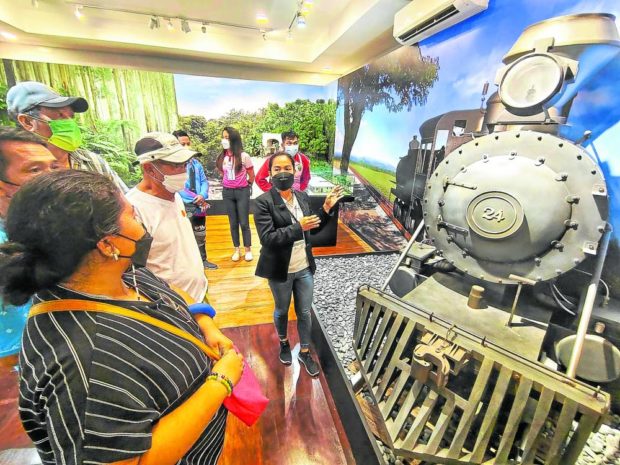
A tour guide leads visitors at the Museo Naga which houses a collection of things that speak about its rich history. Among those displayed is a figure of a train whose steam engines were ignited by coals—a combustible black or brownish-black sedimentary rock with a high amount of carbon and hydrocarbons and found in the City of Naga. (Photo courtesy of the City of Naga government)
CEBU CITY, Cebu, Philippines — The park along Barangay East Poblacion in the City of Naga, Cebu, used to be just a canopy of acacia and narra trees before it has been transformed into a world-class park, complete with interlocking circles of elevated walkways, fountains, benches and rest areas.
Dubbed as “Pasilong sa Naga,” which means “to find shade in Naga,” this P75.4-million park has been built to address the need for more open spaces in the city.
“This park shall be a place for health and well-being accessible by all. With this park, we want to erase the misconception of people that the government is not capable of providing a facility such as this, because through partnership, it can be done,” said Naga Mayor Kristine Vanessa Chiong.
The 6,407 square-meter park, inaugurated on Oct. 7, was designed by world-renowned Cebuano designer Kenneth Cobonpue who agreed to make the project blueprint for free.
Aside from Pasilong sa Naga, the city government also unveiled the Museo Naga which houses a collection of items that speak about the city’s history.
Article continues after this advertisement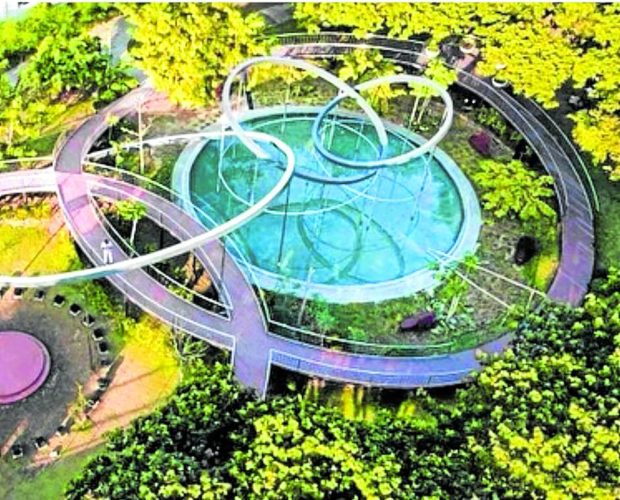
GREEN SPACE An overview of “Pasilong sa Naga,” an urban green space designed by internationally renowned Cebuano designer Kenneth Cobonpue. —PHOTO COURTESY OF KENNETH COBONPUE.
Industrial hub
Naga, which is located 20.5 kilometers south of Cebu City, is known as the industrial hub in southern Cebu with a population of 133,184 based on the 2020 census.
Article continues after this advertisementCobonpue, in a post on Facebook, said Pasilong sa Naga featured interlocking rings that “represent circles of life, and nature’s way of taking and giving back to the earth.”
The rings vary in scale with its ups and downs to represent life’s journey.
There are also benches and rest areas near the water fountain, inviting guests to enjoy the beauty of nature.
Cobonpue said he made sure not a single tree was removed when the park was rehabilitated.
The acacia trees in the area date back to the time of the Americans from 1898 to 1935. Also planted in the park were narra trees where the city got its name.
According to its official website, Naga was previously named by the first settlers as “Narra” due to the abundance of this tree. The name subsequently became what is now known as “Naga.”
“May all who visit Pasilong sa Naga find calm and comfort in the meditative fall of water, and discover one’s self in the pathways that symbolize the cycle of our lives,” Cobonpue said.
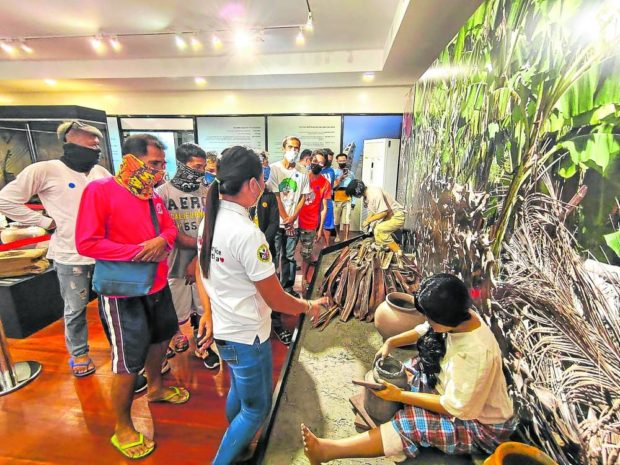
Among those displayed at the Museo Naga are images that depict how residents formed pots out of clay which was endemic in the City of Naga many decades ago. One village is currently known as Colon which was derived from the Cebuano word “con” or pot.
Inspiration
Chiong expressed hopes that Pasilong sa Naga would inspire other local governments to create green and open spaces for their constituents as well as entice more people to support the local tourism industry.
“People stay here to commune and come together as families and friends, especially during this time of pandemic. We badly need open and public spaces where we can unwind,” she told the Inquirer.
Pasilong sa Naga, which broke ground in 2018, is open to the public.
Ruth Bandola Alensonorin, the city’s information and community relations officer, said P65 million of the P75-million budget for the project came from the city’s coffers.
The rest came from the Department of Budget and Management under its Green, Green, Green program, which aims to make the country’s 145 cities more livable and sustainable through the development of public open spaces.
“We want to provide residents and guests a space where one can enjoy nature and culture. This park is a tangible reflection of the Nagahanons’ quality of life where families bond, relax and enjoy the aesthetic surroundings,” said Alensonorin who also serves as the city’s tourism and heritage development officer.
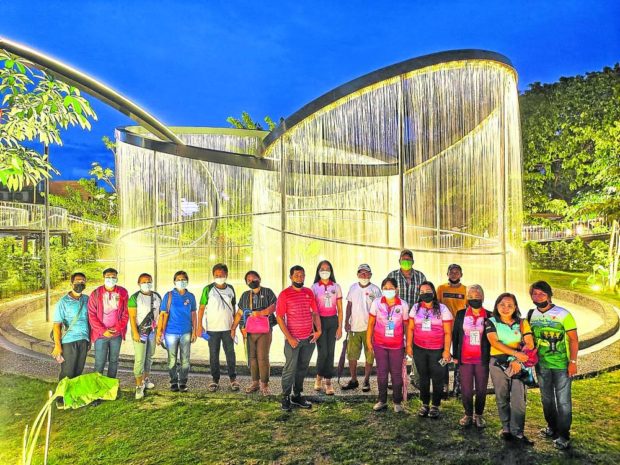
SOUVENIR SHOT A fountain serves as a backdrop for visitors wanting to take snaps after a tour of “Pasilong sa Naga.”—PHOTO COURTESY OF CITY OF NAGA GOVERNMENT
Learning history
Located across the park is the P3-million Museo Naga, the city’s public museum.
Museo Naga is a place where Nagahanons and guests learn the city’s history, environment and development through time.
“As a repository of local knowledge and artifacts, it is a creative way to transmit the city’s heritage and aspirations to the next generation,” Alensonorin said.
According to Jocelyn Gerra, curatorial consultant of the City of Naga, the museum is divided into three galleries: Natural History, Naga Heritage and Contemporary Gallery, and the Leaders’ Gallery.
The Natural History gallery shows, among others, the coal mines and the limestone where the thriving cement industry was founded during the American colonial period.
“It (coal) is important for two things: to fire steam engines of trains, and to process cement,” Gerra said.
Another gallery inside the museum highlights the city’s heritage.
Unknown to many, Gerra said Naga used to be rich in clay which was used for pottery.
One village, she added, is known as Colon, a name derived from the Cebuano word “con,” or pot.
Sources of clay in Naga, however, dwindled after areas where people took them were acquired by private individuals.
Aside from pottery, Naga was also home to trees or shrubs that were used to dye different materials, paving the way for the establishment of a village now known as Tinaan, which was taken from the Cebuano word “tina,” or dye.
When the Spaniards arrived, they explored the coal mining in the upland barangays of Naga. Coal eventually became the first export product of Naga. Cement comes as the city’s next top export.
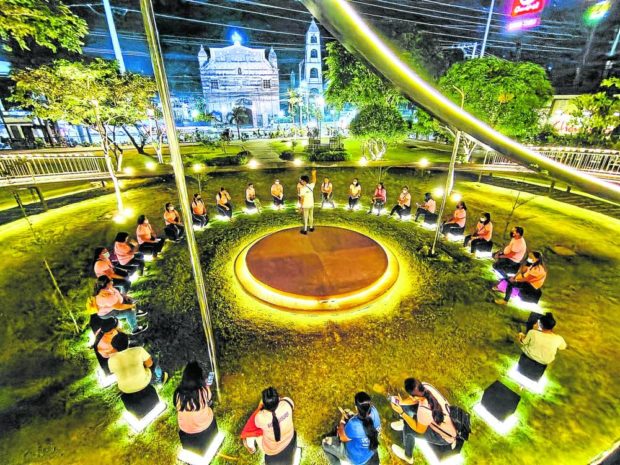
HISTORY IN THE HEART OF THE CITY Visitors sit on concrete slabs while listening to a tour guide at “Pasilong sa Naga” in the City of Naga, south Cebu. Across the park is the church of St. Francis of Assisi, the city’s patron saint. —PHOTO COURTESY OF CITY OF NAGA GOVERNMENT
Old settlement
The Museo Naga also features city leaders as well as a study or reading center where information about the city is deposited.
Due to the COVID-19 pandemic, Gerra said most of the tours were arranged prior to the actual visit.
“One of the goals of the mayor is for people of Naga to know their history and environment. Know your place first. For guests, it is also a way of knowing the community they are visiting,” said Gerra, who is also the curator and consultant of the Sugbu Chinese Heritage Museum and a member of the Cebu City Cultural and Historical Affairs Commission.
Considered as one of the oldest settlements in the province of Cebu, Naga became a municipality on June 12, 1829.
In 2011, the cityhood status of Naga and 15 other local governments in the country was deemed official, constitutional and final by the Supreme Court following a series of rulings that either supported or opposed their change in status.
As the number of manufacturing companies and other industries flourished in Naga, it eventually gained its new status from first class municipality into a component city in the first congressional district of Cebu.
Chiong urged other town and city leaders in the country to also invest in public spaces and contemporary projects.
“While we honor our history, while we want to preserve our heritage, we also look forward to the future through technology and modernization. This is not merely aesthetics, but enriching our quality of life,” she said.